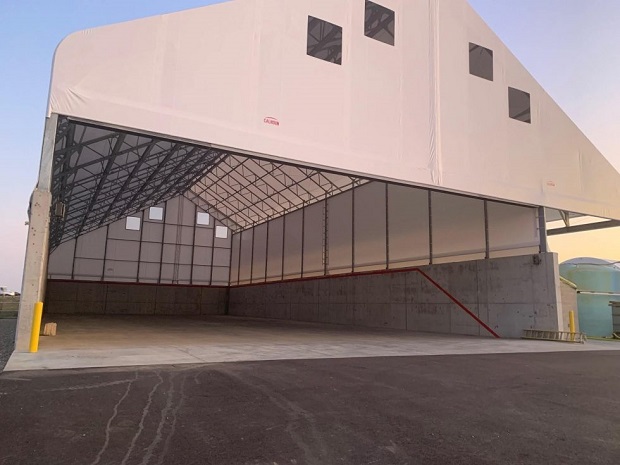Calhoun Super Structure
The Cost of Fabric Structures

When assessing the cost differences between fabric building costs and traditional structures like wood, steel, or concrete, the information can be overwhelming.
What’s critical to know are the long-term and short-term cost benefits, as well as the indirect and direct fabric building cost benefits.
In most cases, fabric building costs significantly less than traditional wood, steel, or concrete buildings, and the cost savings can be enjoyed on both upfront building costs and maintenance costs over time. Keep reading to learn how fabric buildings save you money.
Material Costs
Costs of materials for building projects can vary greatly depending on size and current market prices. While steel frames typically have higher material costs than wood, wood buildings typically must account for 15% to 20% waste overages and sheathing which amounts to another 15% to 20% of material costs. Add in long-term weather damage, pests, mold, warping, or rot, and you’ve spent more than a steel frame structure.
In comparison to fabric building costs (which incorporate a certain amount of steel material in its frame), you still save greatly on the fabric roof. At its minimum, a full steel building can start at $12.50 per square foot and increase from there. With a fabric structure, costs per square foot can be as low as $4 to $7.
Labour Costs
Construction time is a necessity in any building project, but what counts is the hours spent on site prep, foundations, erecting the framework, roofing, and finishing. Unlike the labour-intensive construction of wood, steel, or concrete buildings, fabric buildings are typically quicker to install given slightly fewer materials and the simplicity of installing fabric.
Depending on the size and therefore amount of steel frame to erect in a fabric building, steel frames can be erected anywhere from a few hours to a few days. Max. The fabric is then either pulled across the building in one seamless bag cover, or installed in individual panels, both options of which again take anywhere from a few hours to a few days.
On average, fabric buildings require .02 to .03 man hours per square foot installed versus .04 to .07 man hours per square foot installed for steel sheeting which could save you hundreds of man hours on a 20,000 square foot facility or larger.
Maintenance Costs
Most wood, steel, or concrete buildings require annual maintenance such as painting or staining in addition to re-roofing, re-shingling, or re-tarring. Especially if you live somewhere with cold or wet seasons. Money is spent on even more materials and even more labour time.
With a fabric building, costs are saved on annual maintenance. Since fabric buildings do not have screws or nails along the roof line, areas for moisture entry are mitigated thereby reducing leaks, rust, or corrosion. Unlike full steel buildings, the steel frames in fabric buildings are typically hot dip galvanized, further protecting against corrosion. Additionally, the fabric itself is immune to rust and corrosion, and does not break down from UV rays, further keeping your building free from maintenance.
Should a fabric repair or replacement arise, fixes can be done with a patch kit or the removal of an individual fabric panel. On average, repair costs be as low as $2 per square foot for fabric buildings whereas replacement steel can cost up to $7 per square foot.
Electricity Costs
Fabric buildings typically offer anywhere from 16% to 19% translucency which means the interior receives an abundance of natural daylight – one critical differentiator from traditional wood, steel, or concrete buildings. Without the natural light in a traditional building, windows, skylights, and artificial lighting is required. On average, windows can cost upwards of $500 each; skylights upwards of $200 each. On a monthly basis, electricity costs tend to be over $100, multiplied over the course of years you end up spending thousands long-term on lighting.
Furthermore, fabric structures typically only require 1/3 of lighting for nighttime use since the underside of the fabric roof reflects and disperses any artificial lighting you do have inside. Thus, you also save on the amount of artificial lights you need to purchase.
Both short-term and long-term, fabric structures save you thousands of dollars on lighting alone. To further offset energy costs, solar panels can be added to the fabric building design and installed on top of the fabric roof.
Ventilation
Heating and cooling costs in traditional buildings are significantly higher since the heating and cooling units need to work harder.
Since fabric buildings are naturally non-conductive, the interior of a fabric building remains cooler on hot days warmer on cool days. The fabric does not retain heat from the sun thus maintaining interior temperatures.
To further improve ventilation in fabric buildings, side vents, end wall vents, roof vents, make-up air systems, and radiant tubes can all be added to the structure. With Calhoun’s high top design and versatile profile design, high roof peaks further offer a large volume of air space and circulation.
In essence, ventilation and heating and cooling systems do not need to compete with the many sources of air flow as in traditional wood, steel, or concrete buildings.
Conclusion
For many industries, fabric structures provide a cost-efficient and time saving alternative to traditional structures. By cutting your construction time down significantly, you can move into your fabric building quicker and get to work. Also, lower costs for maintenance, lighting, and ventilation provide long-term cost savings to put extra money back in your pocket over time.
Source: https://calhounsuperstructure.com/the-cost-of-fabric-structures/
Careers with Calhoun
At Calhoun Super Structures, we believe that our strength is in our structure. Not just the structure of our fully engineered line of fabric covered buildings, but the structure of our company, our employees and our dealer network.